Joint User Association and Power Control in UAV Network: A Graph Theoretic Approach
Abstract
1. Introduction
- The UAV-user aerial network will be considered to handle the UAV-user association problem by jointly optimizing its spectral and energy efficiencies, especially in post-disaster relief scenarios.
- Toward that, we will utilize the concept of graph theory, specifically the bipartite graph theory, and propose the MwMaxFlow approach to address it. In this approach, the MWM algorithm maximizes the data rates among UAV users by matching (i.e., associating) users to UAVs based on their achievable data rates relative to their traffic demands. Then, the MaxFlow algorithm is utilized to maximize the flow of the whole network constrained by the maximum capacities of UAVs.
- Based on the UAV-user association created in the first step, the UE’s transmit powers are optimized using the -matrix theory to reduce the UE’s energy consumption while maintaining the minimum data flow optimized by the MwMaxFlow algorithm. Overall, the two proposed schemes, i.e., the MwMaxFlow-based UAV-user association and the -matrix theory-based UE power control, maximize both the spectral and energy efficiencies of the UAV-user network while considering users’ traffic demands and UAVs’ maximum capacities.
- Simulation results demonstrate the effectiveness of the proposed solutions, showing significant improvements in spectral and energy efficiencies compared with other benchmarks. Specifically, the proposed MwMaxFlow achieves a 90% improvement in spectral efficiency compared with the ordinary MaxFlow algorithm in some scenarios. The proposed approach also achieves the highest energy efficiency among the compared benchmark schemes.
2. Related Work
3. Proposed System Model
3.1. UAV-UE Channel Model
3.2. Optimization Problem Formulation
- C1:
- C2:
- C3:
- C4:
- C5:
4. Proposed UAV-User Association and Power Control
4.1. Proposed Graph-Based UAV-User Association
4.1.1. Maximum Weighted Matching for UAV-UE Association
4.1.2. MaxFlow for Spectral Efficiency Maximization
- C1:
- C2:
- C3:
- C4:
- C5:
| Algorithm 1: Proposed MwMaxFlow Approach |
 |
4.2. Power Control
5. Numerical Analysis
5.1. Performance Comparisons without Using Power Control
5.2. Performance Comparisons with Using Power Control
5.3. Complexity Analysis
6. Limitations of The Proposed Approach
7. Conclusions
Author Contributions
Funding
Data Availability Statement
Conflicts of Interest
References
- Mozaffari, M.; Saad, W.; Bennis, M.; Nam, Y.H.; Debbah, M. A Tutorial on UAVs for Wireless Networks: Applications, Challenges, and Open Problems. IEEE Commun. Surv. Tutor. 2019, 21, 2334–2360. [Google Scholar] [CrossRef]
- Hashesh, A.O.; Hashima, S.; Zaki, R.M.; Fouda, M.M.; Hatano, K.; Eldien, A.S.T. AI-Enabled UAV Communications: Challenges and Future Directions. IEEE Access 2022, 10, 92048–92066. [Google Scholar] [CrossRef]
- Alnakhli, M. Optimizing spectrum efficiency in 6G multi-UAV networks through source correlation exploitation. EURASIP J. Wirel. Commun. Netw. 2024, 2024, 6. [Google Scholar] [CrossRef]
- Fotouhi, A.; Qiang, H.; Ding, M.; Hassan, M.; Giordano, L.G.; Garcia-Rodriguez, A.; Yuan, J. Survey on UAV Cellular Communications: Practical Aspects, Standardization Advancements, Regulation, and Security Challenges. IEEE Commun. Surv. Tutor. 2019, 21, 3417–3442. [Google Scholar] [CrossRef]
- Amrallah, A.; Mohamed, E.M.; Tran, G.K.; Sakaguchi, K. UAV Trajectory Optimization in a Post-Disaster Area Using Dual Energy-Aware Bandits. Sensors 2023, 23, 1402. [Google Scholar] [CrossRef]
- Amrallah, A.; Mahmoud, M.E.; Khanh, T.G.; Sakaguchi, K. Optimization of UAV 3D trajectory in a post-disaster area using dual energy-aware bandits. IEICE Commun. Express 2023, 12, 403–408. [Google Scholar] [CrossRef]
- Mohamed, E.M.; Hashima, S.; Hatano, K. Energy Aware Multiarmed Bandit for Millimeter Wave-Based UAV Mounted RIS Networks. IEEE Wirel. Commun. Lett. 2022, 11, 1293–1297. [Google Scholar] [CrossRef]
- Mohamed, E.M.; Alnakhli, M.; Hashima, S.; Abdel-Nasser, M. Distribution of Multi MmWave UAV Mounted RIS Using Budget Constraint Multi-Player MAB. Electronics 2023, 12, 12. [Google Scholar] [CrossRef]
- Jin, H.; Jin, X.; Zhou, Y.; Guo, P.; Ren, J.; Yao, J.; Zhang, S. A survey of energy efficient methods for UAV communication. Veh. Commun. 2023, 41, 100594. [Google Scholar] [CrossRef]
- Alsamhi, S.H.; Ma, O.; Ansari, M.S. Survey on artificial intelligence based techniques for emerging robotic communication. Telecommun. Syst. 2019, 72, 483–503. [Google Scholar] [CrossRef]
- Ju, Y.; Cao, Z.; Chen, Y.; Liu, L.; Pei, Q.; Mumtaz, S.; Dong, M.; Guizani, M. NOMA-Assisted Secure Offloading for Vehicular Edge Computing Networks with Asynchronous Deep Reinforcement Learning. IEEE Trans. Intell. Transp. Syst. 2023, 1–14. [Google Scholar] [CrossRef]
- Song, H.; Bai, J.; Yi, Y.; Wu, J.; Liu, L. Artificial Intelligence Enabled Internet of Things: Network Architecture and Spectrum Access. IEEE Comput. Intell. Mag. 2020, 15, 44–51. [Google Scholar] [CrossRef]
- Hammouti, H.E.; Hamza, D.; Shihada, B.; Alouini, M.S.; Shamma, J.S. The Optimal and the Greedy: Drone Association and Positioning Schemes for Internet of UAVs. IEEE Internet Things J. 2021, 8, 14066–14079. [Google Scholar] [CrossRef]
- Bai, C.; Yan, P.; Yu, X.; Guo, J. Learning-based resilience guarantee for multi-UAV collaborative QoS management. Pattern Recognit. 2021, 122, 108166. [Google Scholar] [CrossRef]
- Han, S.I. Survey on UAV Deployment and Trajectory in Wireless Communication Networks: Applications and Challenges. Information 2022, 13, 389. [Google Scholar] [CrossRef]
- Shakhatreh, M.; Shakhatreh, H.; Ababneh, A.A. Efficient 3D Positioning of UAVs and User Association Based on Hybrid PSO-K-Means Clustering Algorithm in Future Wireless Networks. Mobile Information Systems 2023, 2023, 6567897. [Google Scholar] [CrossRef]
- Siddiqui, A.B.; Aqeel, I.; Alkhayyat, A.; Javed, U.; Kaleem, Z. Prioritized User Association for Sum-Rate Maximization in UAV-Assisted Emergency Communication: A Reinforcement Learning Approach. Drones 2022, 6, 45. [Google Scholar] [CrossRef]
- Xi, X.; Cao, X.; Yang, P.; Chen, J.; Quek, T.; Wu, D. Joint User Association and UAV Location Optimization for UAV-Aided Communications. IEEE Wirel. Commun. Lett. 2019, 8, 1688–1691. [Google Scholar] [CrossRef]
- El Hammouti, H.; Benjillali, M.; Shihada, B.; Alouini, M.S. Learn-As-You-Fly: A Distributed Algorithm for Joint 3D Placement and User Association in Multi-UAVs Networks. IEEE Trans. Wirel. Commun. 2019, 18, 5831–5844. [Google Scholar] [CrossRef]
- Cheng, F.; Zou, D.; Liu, J.; Wang, J.; Zhao, N. Learning-Based User Association for Dual-UAV Enabled Wireless Networks with D2D Connections. IEEE Access 2019, 7, 30672–30682. [Google Scholar] [CrossRef]
- Sun, Y.; Wang, T.; Wang, S. Location Optimization and User Association For Unmanned Aerial Vehicles Assisted Mobile Networks. IEEE Trans. Veh. Technol. 2019, 68, 10056–10065. [Google Scholar] [CrossRef]
- Yin, S.; Li, L.; Yu, F.R. Resource Allocation and Basestation Placement in Downlink Cellular Networks Assisted by Multiple Wireless Powered UAVs. IEEE Trans. Veh. Technol. 2020, 69, 2171–2184. [Google Scholar] [CrossRef]
- Plachy, J.; Becvar, Z.; Mach, P.; Marik, R.; Vondra, M. Joint Positioning of Flying Base Stations and Association of Users: Evolutionary-Based Approach. IEEE Access 2019, 7, 11454–11463. [Google Scholar] [CrossRef]
- Qiu, C.; Wei, Z.; Yuan, X.; Feng, Z.; Zhang, P. Multiple UAV-Mounted Base Station Placement and User Association with Joint Fronthaul and Backhaul Optimization. IEEE Trans. Commun. 2020, 68, 5864–5877. [Google Scholar] [CrossRef]
- Yu, C.S. Graph theory, by W. T. Tutte, Encyclopedia of Mathematics and its Applications, Volume 21, Addison-Wesley Publishing Company, Menlo Park, CA., 1984, 333 pp. Price: 45.00. Networks 1986, 16, 107–108. [Google Scholar] [CrossRef]
- Hande, P.; Rangan, S.; Chiang, M.; Wu, X. Distributed Uplink Power Control for Optimal SIR Assignment in Cellular Data Networks. IEEE/ACM Trans. Netw. 2008, 16, 1420–1433. [Google Scholar] [CrossRef]
- Chen, Y.; Wong, W.S. Power control for non-Gaussian interference. In Proceedings of the 7th International Symposium on Modeling and Optimization in Mobile, Ad Hoc, and Wireless Networks, Seoul, Republic of Korea, 23–27 June 2009; pp. 1–8. [Google Scholar]
- Masroor, R.; Naeem, M.; Ejaz, W. Resource management in UAV-assisted wireless networks: An optimization perspective. J. Netw. Comput. Appl. 2022, 205, 103439. [Google Scholar] [CrossRef]
- Zeng, Y.; Zhang, R.; Lim, T.J. Wireless communications with unmanned aerial vehicles: Opportunities and challenges. IEEE Commun. Mag. 2016, 54, 36–42. [Google Scholar] [CrossRef]
- Alnakhli, M.; Anand, S.; Chandramouli, R. Joint Spectrum and Energy Efficiency in Device to Device Communication Enabled Wireless Networks. IEEE Trans. Cogn. Commun. Netw. 2017, 3, 217–225. [Google Scholar] [CrossRef]
- Poole, G.D.; Boullion, T.L. A Survey on M-Matrices. Siam Rev. 1974, 16, 419–427. [Google Scholar] [CrossRef]
- Meyer, C.D. Matrix Analysis and Applied Linear Algebra; SIAM: Philadelphia, PA, USA, 2000. [Google Scholar]
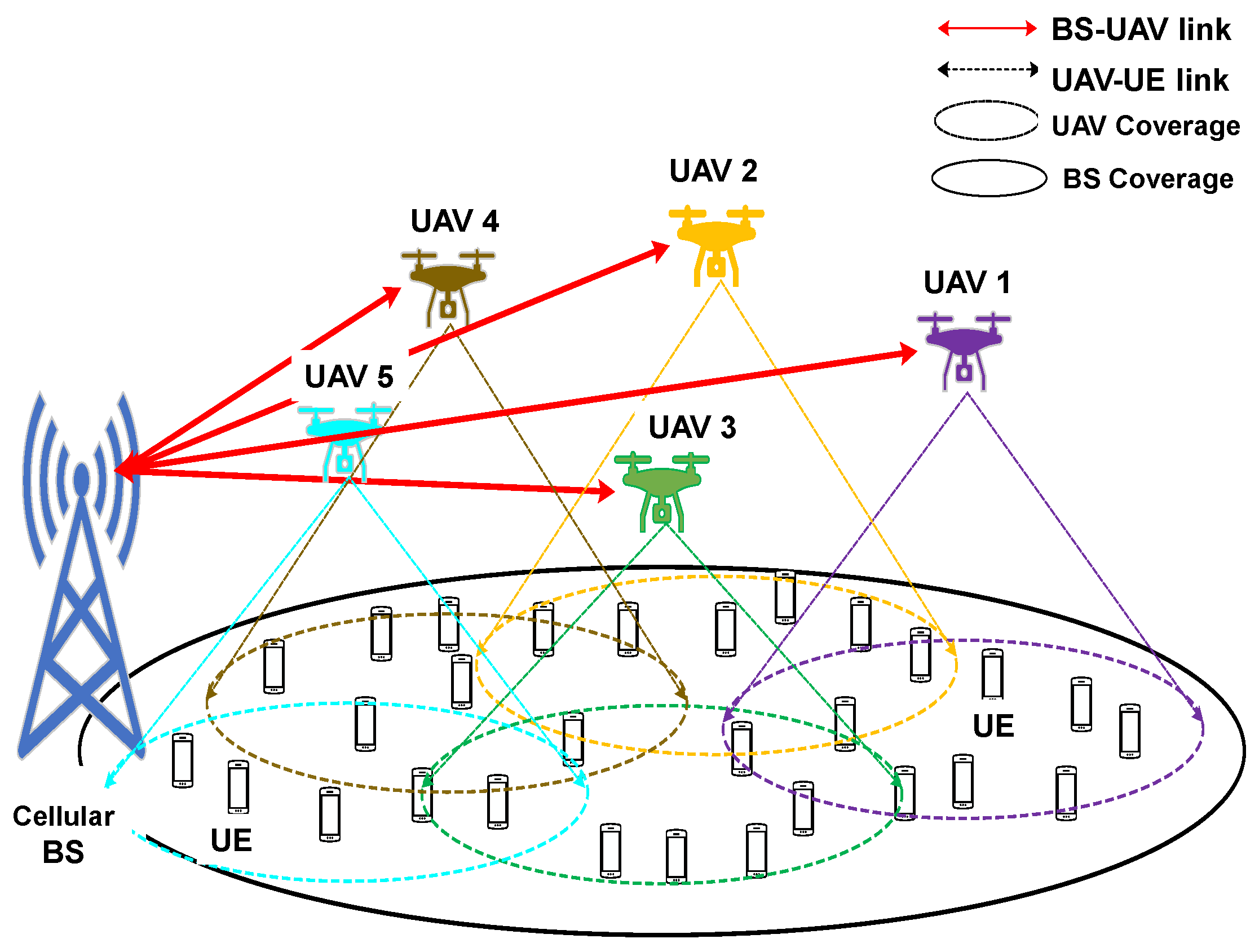


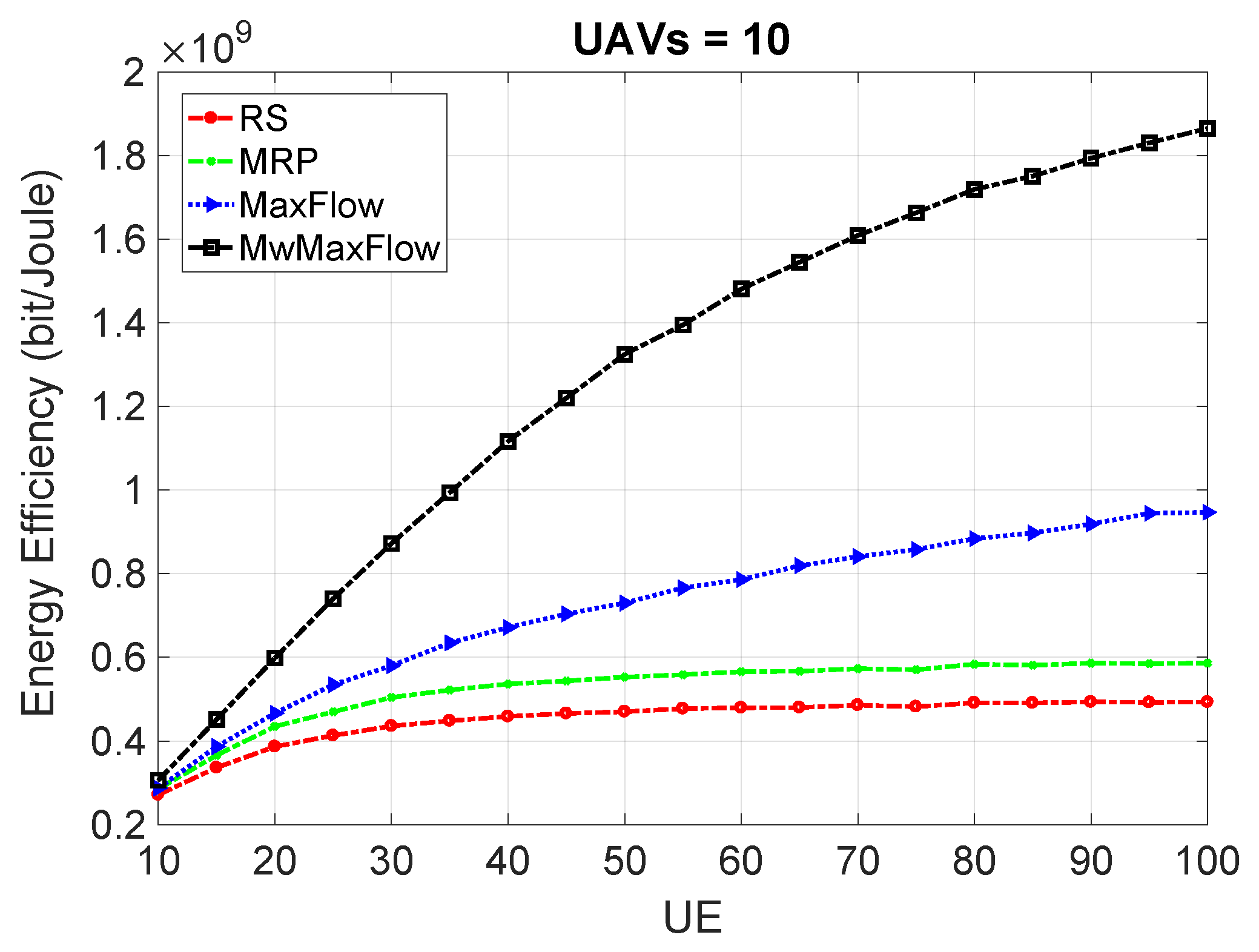
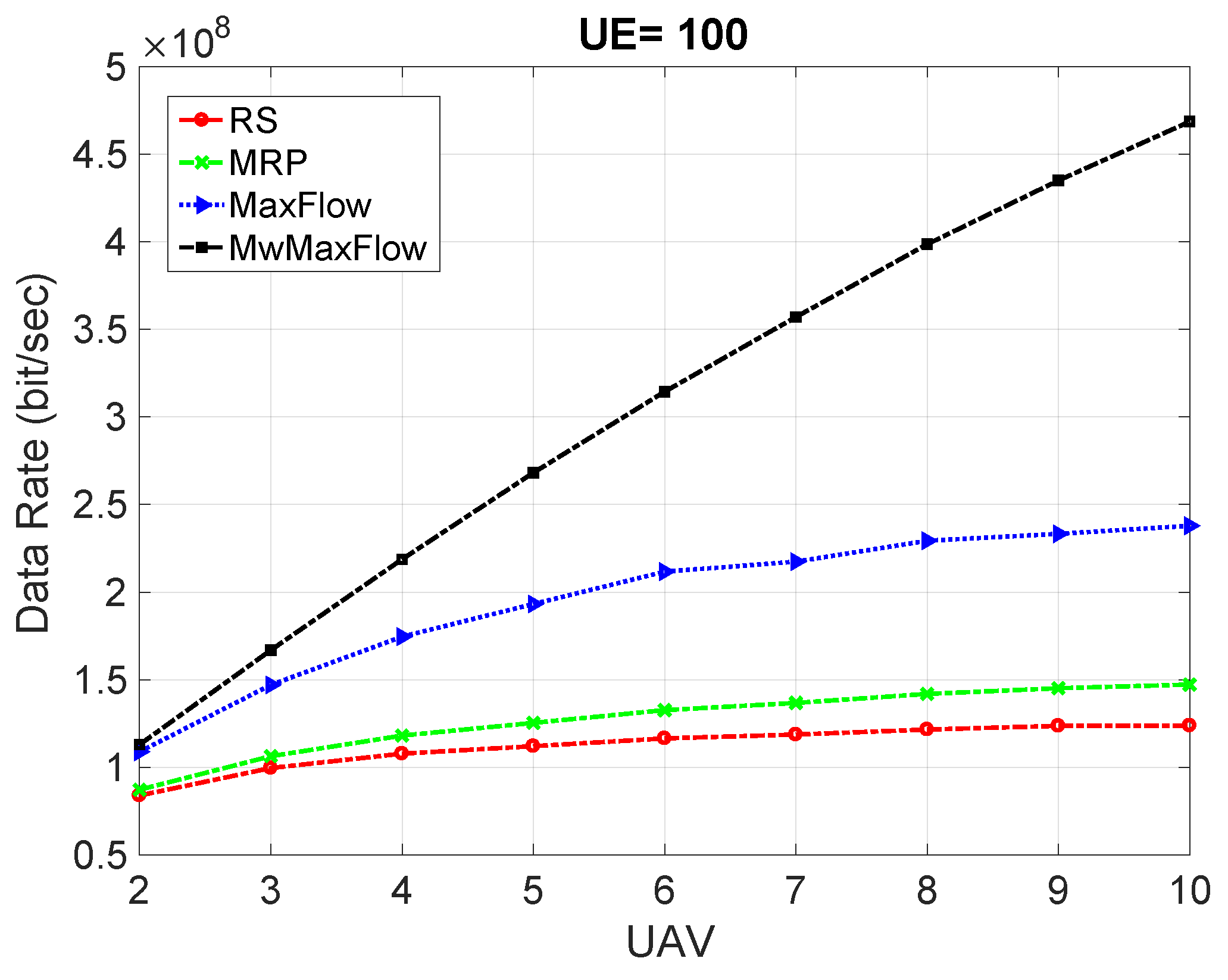

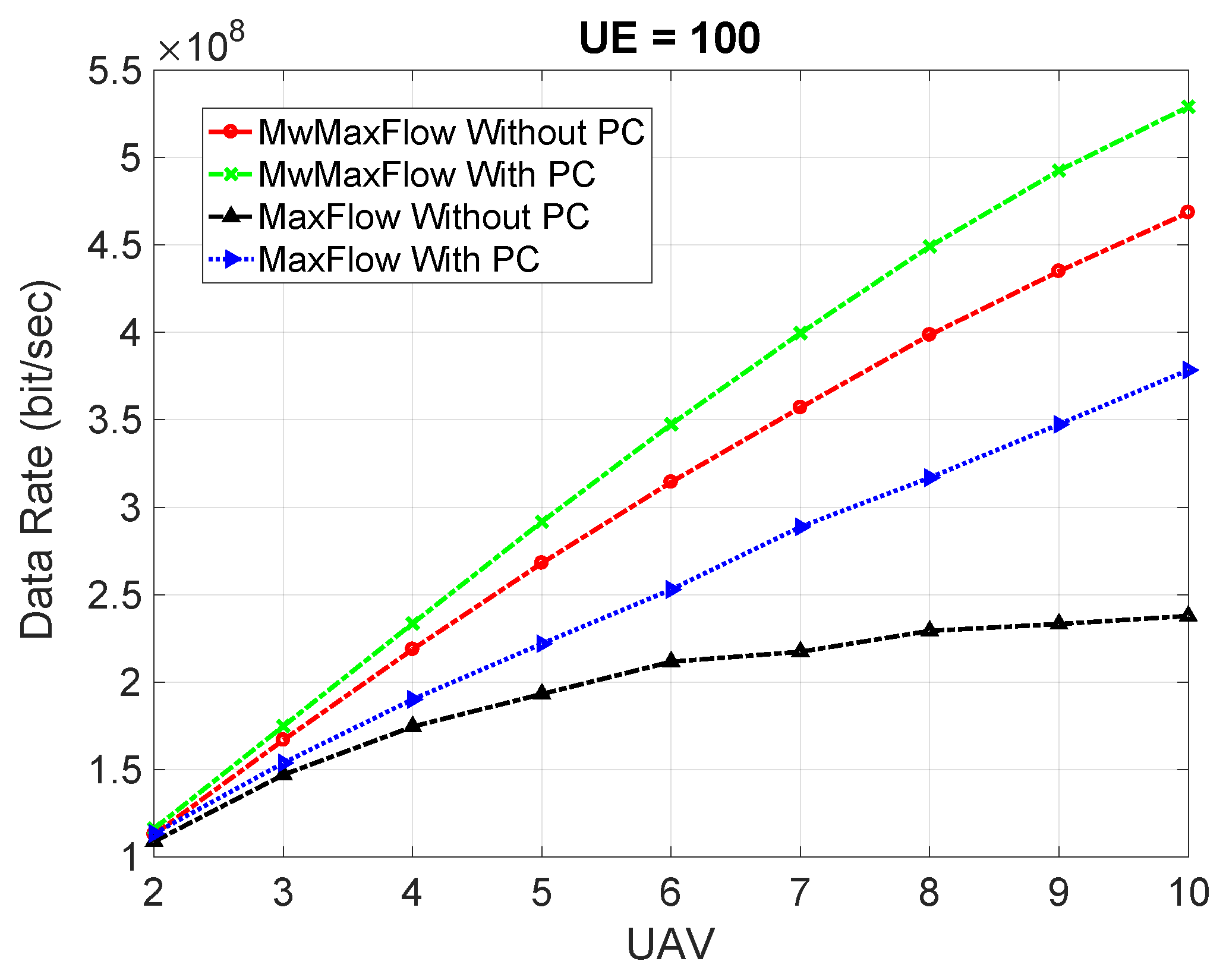
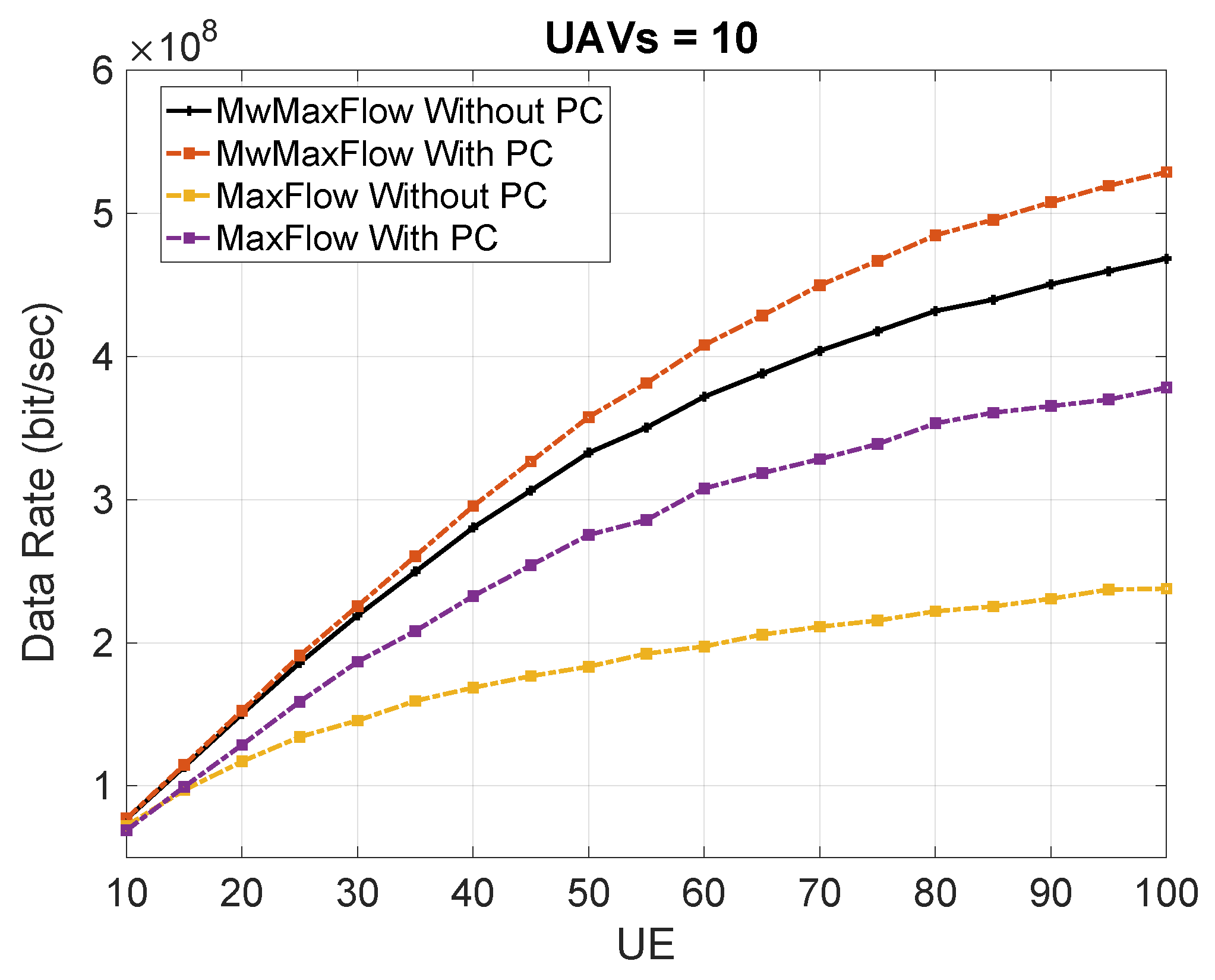


Disclaimer/Publisher’s Note: The statements, opinions and data contained in all publications are solely those of the individual author(s) and contributor(s) and not of MDPI and/or the editor(s). MDPI and/or the editor(s) disclaim responsibility for any injury to people or property resulting from any ideas, methods, instructions or products referred to in the content. |
© 2024 by the authors. Licensee MDPI, Basel, Switzerland. This article is an open access article distributed under the terms and conditions of the Creative Commons Attribution (CC BY) license (https://creativecommons.org/licenses/by/4.0/).
Share and Cite
Alnakhli, M.; Mohamed, E.M.; Abdulkawi, W.M.; Hashima, S. Joint User Association and Power Control in UAV Network: A Graph Theoretic Approach. Electronics 2024, 13, 779. https://doi.org/10.3390/electronics13040779
Alnakhli M, Mohamed EM, Abdulkawi WM, Hashima S. Joint User Association and Power Control in UAV Network: A Graph Theoretic Approach. Electronics. 2024; 13(4):779. https://doi.org/10.3390/electronics13040779
Chicago/Turabian StyleAlnakhli, Mohammad, Ehab Mahmoud Mohamed, Wazie M. Abdulkawi, and Sherief Hashima. 2024. "Joint User Association and Power Control in UAV Network: A Graph Theoretic Approach" Electronics 13, no. 4: 779. https://doi.org/10.3390/electronics13040779
APA StyleAlnakhli, M., Mohamed, E. M., Abdulkawi, W. M., & Hashima, S. (2024). Joint User Association and Power Control in UAV Network: A Graph Theoretic Approach. Electronics, 13(4), 779. https://doi.org/10.3390/electronics13040779









